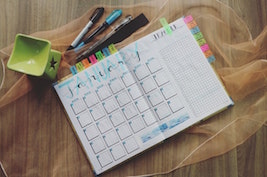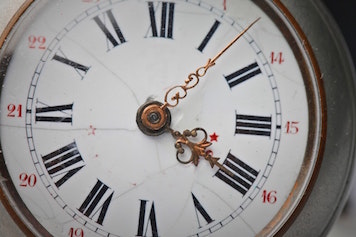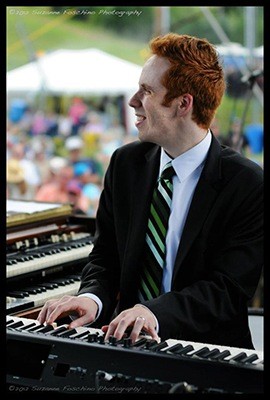Successful Time Management In Jazz Piano Practice
 Do you feel there’s not enough time in the world to do what you need to do?
Do you feel there’s not enough time in the world to do what you need to do?
Would you like to learn successful time management techniques and practice jazz piano smarter?
If so, this is the lesson for you.
In this lesson, we’re going to explore 3 tips to make the most out of your time and get great gains in your jazz piano practice.
Let’s get started.
How To Sort Out Your Day For Jazz Piano Practice
 Finding time for jazz piano practice all starts with identifying your daily routine.
Finding time for jazz piano practice all starts with identifying your daily routine.
Start by identifying all of your essential duties for the day. Write all of these tasks down on a planner or scheduler.
This will help you find vacant spots of about at least 15 minutes to an hour.
Make sure to get an hour of practice time each day. The more time you can get, the better.
Once you’ve identified those practice time slots, mark them off.
Unless there’s an emergency, stick to your daily routine and you’ll find enough time for piano practice.
Now, let’s get into how to maximize those practice slots.
Why Smart Piano Practice Is The Key To Successful Time Management
 Okay. Let’s say you only have a few time slots about 15 to 30 minutes long. You might say it’s not enough.
Okay. Let’s say you only have a few time slots about 15 to 30 minutes long. You might say it’s not enough.
Actually, you can work with that. You just need to practice the smart way.
Practicing smarter instead of longer is much better.
Even if you only have small segments of 15 to 30 minutes a day, you can maximize it.
Smart piano practice involves improving your efficiency.
Let’s look at some great ways for smart piano practice.
1. How To Set Your Piano Practice Priorities
 Start by identifying specific long-term and short-term goals.
Start by identifying specific long-term and short-term goals.
For example, a long-term goal would be to learn how to play Autumn Leaves with hip chord voicings.
Now, write those down on a notebook. This will be your jazz piano practice journal.
Next, identify your short-term goals for achieving those long-term goals.
Let’s start writing down some short-term goals for “Learn How To Play Autumn Leaves”:
- Listen to a couple of arrangements of “Autumn Leaves”
- Learn the melody of Autumn Leaves
- Learn chord voicings and comping for Autumn Leaves
- Put them all together.
 Here’s An Example Of How To Set Piano Practice Priorities
Here’s An Example Of How To Set Piano Practice Priorities
- The first short-term goal can be dealt with through repeated listening. This doesn’t have to be done at the piano or during your specific practice time.
- Next is to learn how to play the melody of the tune either by ear or through sheet music. Take care of refining it in future sessions.
- Spend the next 15 minutes learning the chord progression and chord voicings. Rinse and repeat over the next few practice sessions.
- Practice Autumn Leaves one phrase at a time. The tempo is slow enough where you can make no mistakes. A phrase can be as short as 2 bars. Spend 15 minutes on this portion. Rinse and repeat until it’s perfect then move to the next phrase.
Record all of these on your jazz piano practice journal as well as your progress.
2. How To Set Your Piano Practice Schedule
 It the above example, you have 15 minutes for each component of Autumn Leaves.
It the above example, you have 15 minutes for each component of Autumn Leaves.
Since we basically have 3 items to complete, we need a total of 45 minutes a day.
The good news is you don’t have to go practice all of this 45 minutes straight.
You can break it up throughout the day.
Maybe you only have two 15-minute slots in the morning.That should suffice for learning the melody and the chord voicings.
Your last 15-minute slot is for putting it all together.
Certainly, the more time you put into correct practice, the more gains you get.
However, remember that this is not a race. The important thing is to learn something successfully during those times.
Eventually, you will be able to play Autumn Leaves confidently by doing it this way.
3. How To Use The Pomodoro Technique To Optimize Your Practice Time
 The Pomodoro Technique is simply the use of spaced intervals for practice. It is a very effective technique for successful time management.
The Pomodoro Technique is simply the use of spaced intervals for practice. It is a very effective technique for successful time management.
It’s sort of like working out. All you have to do is allocate 15 to 20 minutes per practice set and then incorporate 5- to 10-minute breaks in between sets.
It’s very important to be free from any distractions during each practice set.
So, if you only have 60 minutes available for practicing, you can easily come up with three 15-minute sets with 5-minute breaks in between.
Make sure to time yourself accurately using a timer, stopwatch, or a clock. An “egg” or “tomato” timer works well in this case.
These techniques are really good, but what if you have to be in a place where there is no piano?
What To Do When A Piano Is Unavailable: Practice “Air Piano”
 Now, what can you do if you’re outside, waiting for someone, and you have no piano available?
Now, what can you do if you’re outside, waiting for someone, and you have no piano available?
Let’s say you’re waiting for your turn in your dentist or doctor’s office: what can you do?
You can use a technique called “mental piano practice”.
Guess what: the greatest musicians, athletes, and performers use shadow or mental practice all the time.
Spectacular examples of musicians who used mental practice include greats like Arthur Rubinstein and Sergei Rachmaninoff.
Research by Nicolo F. Bernardi et al shows that “Mental practice can improve fine motor control in terms of movement velocity, movement timing, and coordination.”
It’s kind of like air guitar or air drumming. You can call it “air piano”.
All you need is a recording of the music you are practicing and/or the sheet music. In some ways this is similar to visualization techniques that many great performers use.
But, it has the added benefit of engaging your body and ear training while you’re learning.
Obviously, you’ll want to still work on the piece back at the piano when you return. But, the “mental piano practice” technique can be a great supplementary tool.
 How To Practice “Air Piano”
How To Practice “Air Piano”
Here’s how to do it:
- Record the passage of music you are practicing at a slow, manageable tempo. This recording should be accurate.
- Imagine you’re sitting in front of a piano.
- While listening to the recording, mime the motions you would use when you’re on a real piano.
- If you have the sheet music with you, read along while miming the motions as well.
Take advantage of the technology available to you when practicing “air piano”. Nowadays, you can have your recordings and sheet music on a smartphone or a tablet.
Now, how do you go further into successful time management? The ideal mentor can help you in that area.
The question is where can you find the ideal jazz piano mentor? Read on.
How A Jazz Piano Mentor Helps You Practice
 Are you having difficulty prioritizing things in your jazz piano practice time?
Are you having difficulty prioritizing things in your jazz piano practice time?
Do you feel ignorant about jazz piano practice essentials?
You may have scoured the web for answers, only to find yourself lost in conflicting opinions.
If you feel that way, what you need is a mentor that knows exactly what to practice to succeed in jazz piano.
The Jazz Inner Circle has instructors that have played on the biggest stages on the world and share every detail with their students to help them achieve massive results.
You now have the opportunity to work with mentors who know exactly what and how to practice jazz piano for success.
In this way, you can guarantee your success.
 Inside the Jazz Inner Circle, you’ll discover:
Inside the Jazz Inner Circle, you’ll discover:
- Private 1:1 lessons with some of the best jazz piano mentors.
- “The Ultimate Jazz Workout Training System.” This is where we implement a complete practice program to build your jazz piano talent in record time.
- Access to over 50 hours of high-level jazz intensive workshops.
- Click here now to and discover how the Jazz Inner Circle can dramatically transform your musical resutls this year. ===>
I hope you enjoyed learning about strategies for successful time management. These should help you raise your jazz piano game to a higher level.
So, what do you think about these practice time management tips? Feel free to leave comments, reactions, additional tips, and suggestions below.
Now it’s time to put all of these into practice, so go to the piano and start making music.
